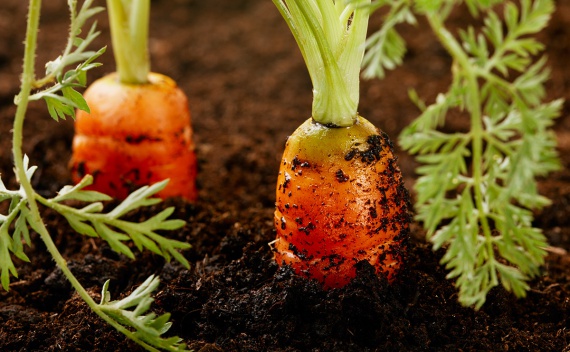The use of natural fertilizers is currently gaining increasing popularity. Natural products can be of plant and animal origin. The use of natural organic fertilizers has a beneficial effect on microorganisms in the soil. So, for example, organic dressings give food to earthworms that loosen the earth, and saturate plants with necessary nutrients, and also thanks to organic dressings, the soil becomes more loose and better allows air and moisture to pass. What kind of folk fertilizer can be used at the cottage, we will describe below.
Table of contents
- Useful properties of ash as a fertilizer in the garden
- Lime to fertilize the soil in the garden in spring
- How can you apply mustard cake in the country
- Proper use of sleeping coffee or coffee grounds
- The use of fallen leaves as a fertilizer in the fall
- How to use sunflower seed husks
- Introduction of straw into the ground
- The benefits and harm of onion peel
- Summary table of organic fertilizer applied on site
Useful properties of ash as a fertilizer in the garden
Many decades ago, our ancestors began to apply the ash, noticing its unique properties. The benefits of the substance is invaluable. Ashes fertilized vegetable gardens, wounds were sprinkled with it, they washed their heads. Its composition is saturated with trace elements residues:
- P (phosphorus);
- Ca (calcium);
- Mg (magnesium);
- Ka (potassium);
- Na (sodium).
The composition of the ash includes a variety of trace elements, with the exception of nitrogen only. The introduction of ash into the soil not only contributes to its enrichment, but also structures it. The level of acidity of the soil decreases, it becomes more friable. Chlorine is not part of the ash, so it is ideal for crops that do not tolerate chlorine.
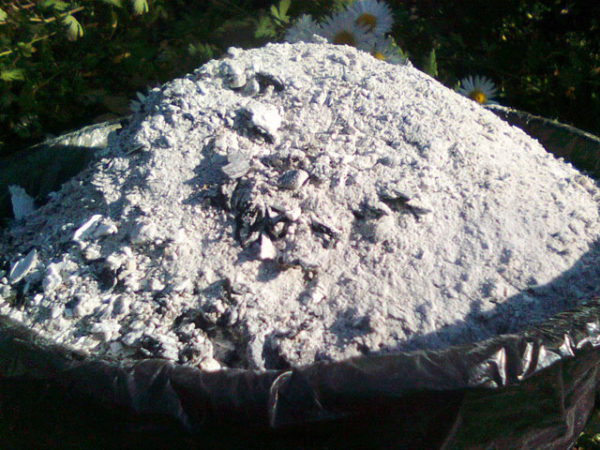
Subject to proper application, the use of ash is possible for the following types of soil:
- Heavy clay soil. When adding ash, the soil will become more crumbly. The amount of application depends on the level of acidity of the soil, taking into account the crops grown in this area. On average, the permissible amount of ash per 1 square. meter ranges from 150 to 810 grams. It is recommended to make ash in this type of soil in the fall.
- Sandy soil. In this kind of soil, ash must be added in the spring so that when melting snow all useful trace elements do not go too deep into the ground with melted snow. Improves the quality of this soil and saturates with useful substances.
- Sour soil. Normalizes acidity, enriches with minerals.
Fertilizer is most favorable for the following plants:
- potatoes - in the process of plowing up the soil for planting at the rate of 1 cup per 1 sq. meter;
- tomatoes, eggplant, pepper - 1.5 cups per 1 square. meter when planting seedlings at a permanent place of growth;
- zucchini, squash, cucumbers - it is necessary to add 1 cup per 1 square meter to the ground. meter;
- onions, garlic - when planting add 2 cups to 1 square meter to the soil. meter;
- beets, parsley, radish, carrots - add 1 cup per 1 square meter to the ground during sowing. meter;
- beans, peas, lettuce, dill - 1 cup per 1 square. meter;
- cabbage - 2 cups per 1 square. meter.
In addition to vegetable crops, ash favorably affects the growth of strawberries, fruit trees, and various kinds of flowers.
When planting trees, 1–2 kilograms of ash mixed with earth are poured into the excavated pit. It is not recommended to fall asleep in its pure form, since upon contact with it, the roots of a plant can get burned.
In the process of growing plants, wood ash is used as a subcortex:
- For potatoes — by performing an earthing up, 1.5 to 3 tablespoons of ash fall asleep under each bush.
- For strawberries, they loosen loosened soil at the rate of 2 cups per 1 square meter. meter.
- Onions and garlic fertilized at the rate of 1 cup per 1 square. meter.
Ash solution is used as a growth promoter for soaking seeds. It is necessary to dilute the ash in the ratio of 20 grams of ash per 1 liter of water.
Abuse leads to the extinction of earthworms in the soil and the bacteria needed by plants to saturate the soil.
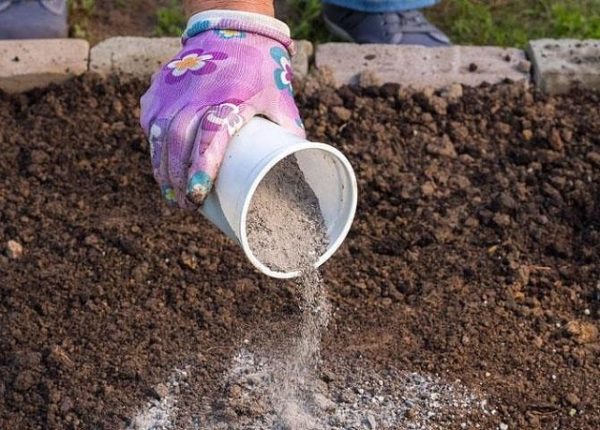
Do not use ash:
- For plants growing in acidic soil — sorrel, pumpkin, turnip, blueberry.
- For flowers — hydrangeas, azaleas, magnolias.
- For young seedlings, before the appearance of 3 leaves on them.
Lime to fertilize the soil in the garden in spring
An important and necessary component to improve the fertility of the soil, containing in its composition Ca and Mg. It is used in the garden to reduce the level of acidity of the soil. Increased acid levels in the soil become a consequence of exhaustion, erosion, and lower yields. As a result, the soil becomes looser and better retains moisture.
Slaked liming is applied to the following types of soil:
- light loam — 240 grams per square meter meter;
- sandy — 250 grams per 1 square meter;
- average loam — 360–750 grams per square meter. meter;
- heavy loam - 400-810 grams per 1 square. meter.
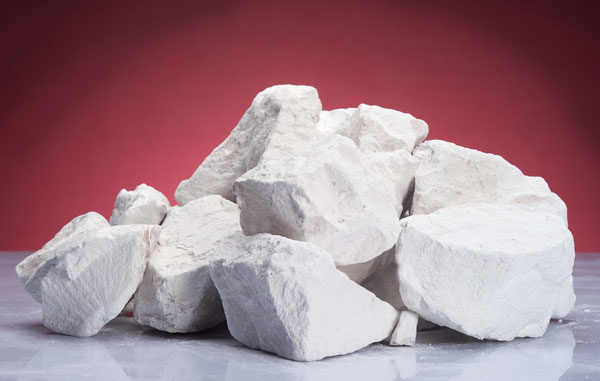
The advantages of pushon are:
- increasing the vital activity of microorganisms living in the soil;
- improvement of soil composition and structure;
- soil enrichment with microelements;
- activization of plant growth;
- a decrease in the level of toxic trace elements in plants.
In the autumn, before the plowing of the soil, the garden lime crumbles on the site, manure or humus is distributed over it, and the soil is plowed up. Due to rains, lime is evenly distributed in the soil, reaching the roots of plants. Thus, the liming procedure will fill the soil with necessary useful components for up to ten years,
You can also spend liming in small portions in the spring before the first loosening of the soil and fertilization. Thanks to lime, the absorbing capacity of the soil is increased and the additional fertilizing is absorbed faster and better. Lime in the amount of 2.5 kilograms must be mixed with humus and distributed on the bed. The effect will be the same as when making ten kilograms of lime powder.
You can make lime flour at home in the following ways:
- Pour out quicklime on a flat surface with a layer of 9 cm and spray it with water using a spray gun.
- Wait 30 minutes for the lime to quench and dry.
- Collect the resulting flour, and spray the remaining lumps again. Perform this procedure until no lumps remain.
Per 100 kg of lime water consumption should be no more than 4 liters.
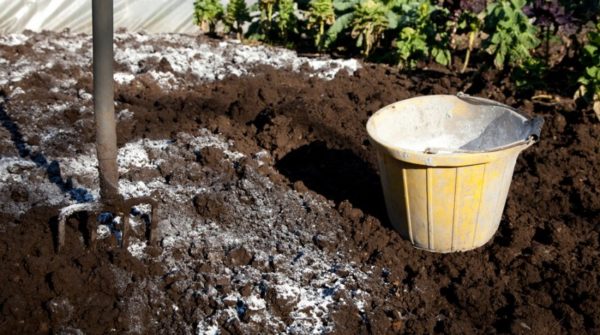
The amount of lime required for entering into the soil is calculated depending on its acidity:
- most acidic (pH less than 4) —550–600 grams per 1 square meter. meter;
- very acidic (pH 4) —450-550 grams per square meter. meter;
- acidic (pH 4-5) —350-450 grams per square meter. meter;
- moderately acidic (pH 5-6) 275-310 grams per 1 square. meter.
When growing potatoes, liming does not apply, as this may weaken its immunity to diseases! Do not use liming when growing carrots and radishes. They stop giving birth.
How can you apply mustard cake in the country
The use of oil cake as a top dressing has two positive aspects:
- increases yield;
- protects plants from diseases and harmful insects.
As a top dressing, only cold-pressed cake, well dried and ground, is suitable. If high temperature conditions were used during squeezing, and chemical means were used, the use of such cake will lead to the inhibition of plants.
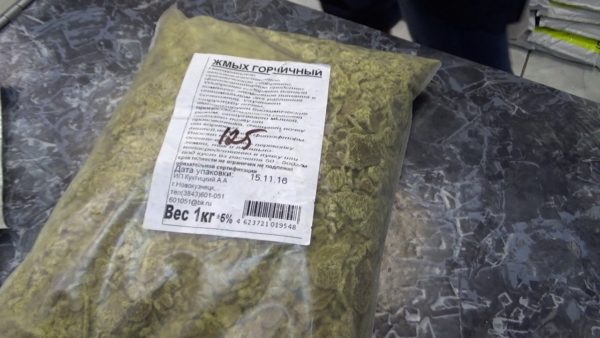
Mustard cake has the following useful properties:
- prevents the development and spread of fungal and putrefactive bacteria, contributing to such diseases as late blight and fusarium;
- repels pests.
The result of the application is:
- improving the quality of the compacted soil;
- when used as mulch, evaporation of moisture is prevented;
- soil contamination by pests and various insects is reduced.
Apply mustard cake should be as follows:
- when planting potatoes, tomatoes, eggplant, pepper it is necessary to pour 1 tablespoon of oil cake into the well;
- for onions and garlic in the grooves evenly distribute a handful of cake on 1 meter;
- when planting strawberries —0.5 tablespoons per well;
- sowing carrots, parsley, celery, beets — 1 handful per 1 meter;
- for cucumbers, squash, zucchini - 1 table spoon.
To enhance the activity of the components, after making the cake it is necessary to sprinkle with earth.
Proper use of sleeping coffee or coffee grounds
Coffee has increasingly become used as an organic dressing in floriculture and horticulture. This type of fertilizer is suitable for all types of soil.
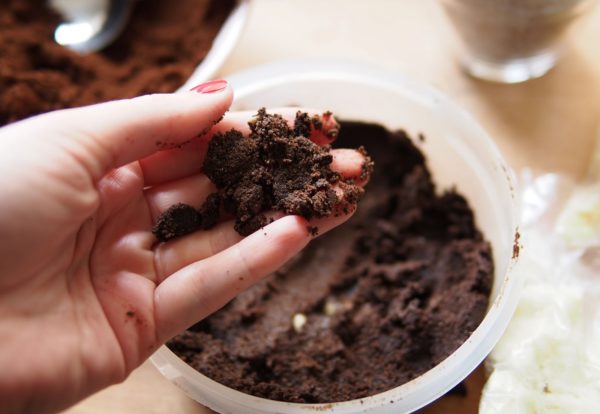
It contains many essential trace elements for plants:
- potassium;
- magnesium;
- calcium;
- phosphorus;
- nitrogen.
Method of use for sleeping coffee:
- thick scatter around holes with plants and plentifully watered with water;
- planting seedlings on a permanent place of growth in the hole to add a little thick. Especially favorable it affects the growth of tomato seedlings;
- used as a drainage layer;
- when mixed with herbal mulch will not form crusts when mulched;
- in diluted form is used for watering;
- mixed with seeds when sowing, resulting in seed germination faster.
You can also make nutritious compost with the addition of coffee grounds. The cooking rate is as follows:
- coffee grounds — 45% of the total mass;
- sluggish grass — 18%;
- dried leaves — 42%
- bone meal — 2.5 handfuls;
- fresh soil — 1 spade.
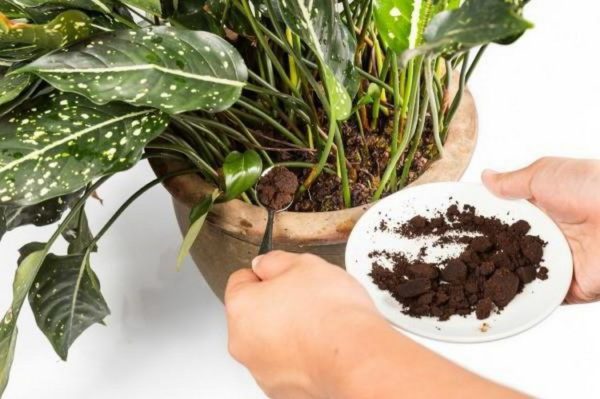
Compost is best prepared in a compost pit. If the pit is not, then you can cook on the ground, but always in a place protected from rain and wind. From above this mixture must be watered with water and mix well. To improve the fermentation process, you can add rotten fruit. With the help of a stick for ventilation in the heap it is necessary to make holes. The larger the pile, the better the maturation of the compost will occur.
When planting fruit trees, it is recommended to add compost to the pit and then scatter it around the trunk. This will help retain moisture and will inhibit the growth of weeds.
The use of fallen leaves as a fertilizer in the fall
At the end of the season, gardeners are trying to get rid of the fallen leaves each in their own way — incineration or disposal of waste. But, Fallen leaves can be used as a fertilizer.
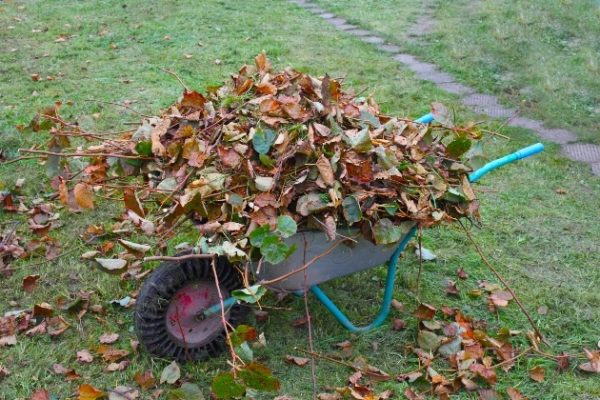
In the fallen leaves contains such trace elements as:
- Ka (potassium);
- Fe (iron);
- Mg (magnesium);
- P (phosphorus);
- S (sulfur);
- Ca (calcium);
- N (nitrogen).
The easiest way to fertilize fruit trees is to dig up the trunk with a radius of 1 meter, remove the top layer of soil to a depth of 25 cm and lay the empty space with fallen leaves, including walnut, with the addition of 500 grams of chicken manure, water and leave for three days.After 3 days, sprinkle the leaves with earth. Pereprevaya, foliage not only saturate the roots of trees with nutrients, but also protects against freezing in cold weather. For compost, you can use not only the fallen leaves, but cabbage, remaining after harvesting.
Another way to use foliage is to make compost:
- In the compost pit laid down the leaves;
- Then dilute nitrogen fertilizers — 25 grams per 1 bucket of water and pour the leaves;
- With the onset of spring, the leaves are stirred and watered again if necessary;
- Compost fertilized vegetation.
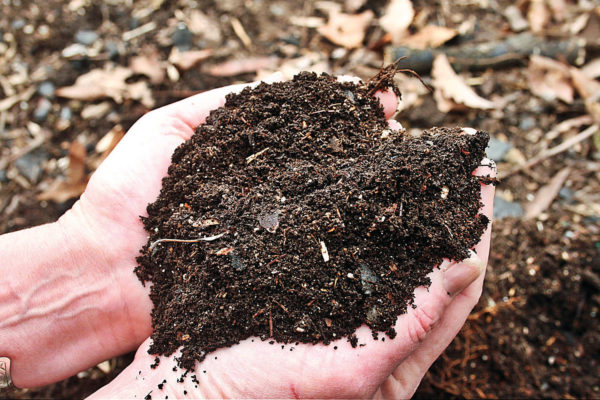
How to use sunflower seed husks
Used for mulching plants, as well as in the form of compost. To obtain compost from sunflower husk, it is better to select a separate container, because the husk decomposes for a long time. After decomposition, it is necessary to mix with mullein, as it is rich in nitrogen, and in the husk it is not enough.
When planting potatoes, tomatoes husk can be put in the hole. In the same way it is used when planting shrubs and trees.
The husks added to the soil will make it more friable and improve water permeability and oxygen access to the root system of plants.
Decomposed on the surface of the soil as mulch husks will not be subject to decomposition. The layer of mulch should be 2.5 cm thick. Such a layer will not allow moisture to evaporate, and will inhibit the growth of weeds.
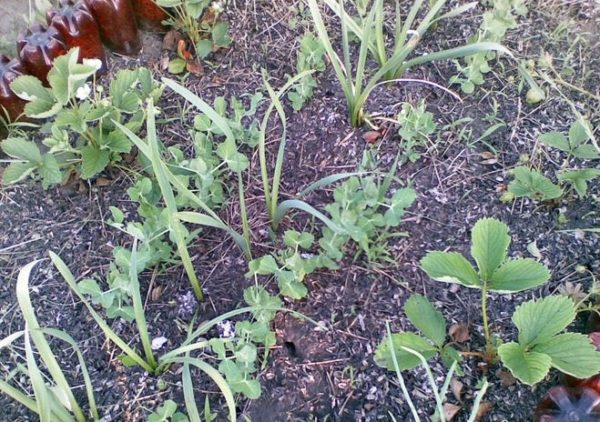
Introduction of straw into the ground
Straw is a dried stalk of cereal and climbing crops. Straw derived from these plant species is used as a fertilizer:
- wheat;
- oats;
- barley;
- peas.
The pure straw introduced in the decomposition process saturates the soil with various acids, which negatively affects the growth of the root system. Therefore, it is necessary to add nitrogen. It neutralizes the negative effects of acids on plants and deoxidation occurs.
Wheat straw contains:
- I (iodine);
- Co (cobalt);
- Mn (manganese);
- Zn (zinc);
- Na (sodium);
- Fe (iron);
- Mg (magnesium);
- vitamin D;
- B vitamins;
- vitamin A.
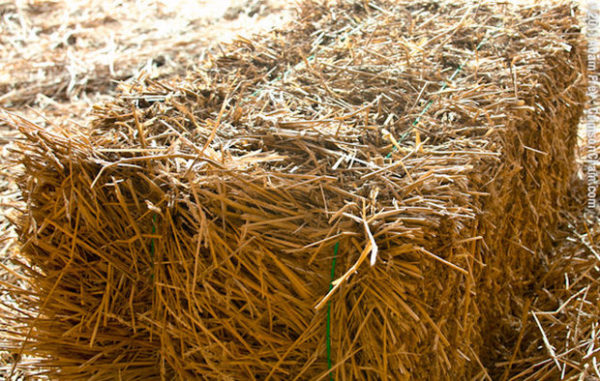
Barley straw is rich in such microelements as:
- Ca (calcium);
- P (phosphorus);
- K (potassium);
- Mg (magnesium);
- I (iodine);
- Fe (iron);
- Na (sodium);
And also contains:
- fiber;
- lysine;
- protein;
- vitamin D;
- vitamin A;
- vitamin PP;
- vitamin E.
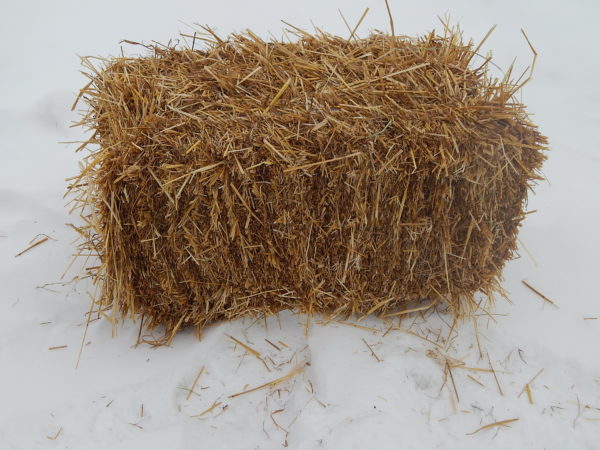
Oat straw is saturated:
- iron;
- cobalt;
- potassium;
- fiber;
- carotene;
- protein.
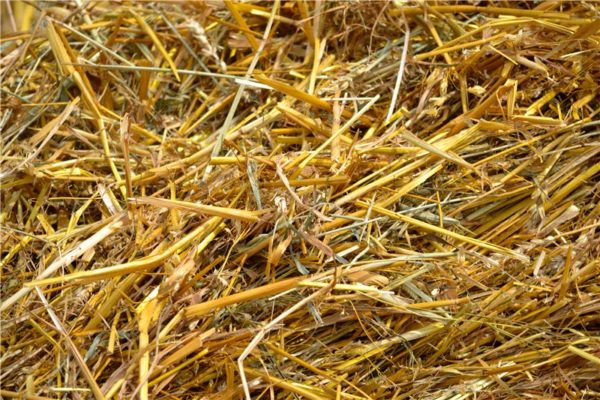
Pea straw incorporates:
- lysine;
- fiber;
- protein;
- phosphorus;
- calcium;
- magnesium;
- vitamin C;
- vitamin PP;
- vitamins of group B.
Also, in addition to soil, straw is used as mulch. It prevents the evaporation of moisture from the beds and weed growth.
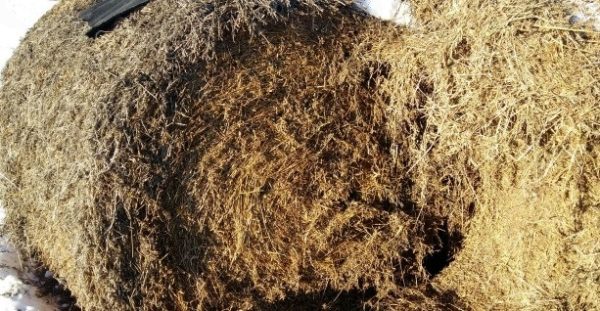
The benefits and harm of onion peel
Apply onion peel as a fertilizer in the form of a decoction, tincture, as well as mulch. The broth is prepared as follows - two glasses of husk (glasses fill well) pour a bucket of water. The water temperature should be 40 degrees. Insist for three and a half hours. Apply:
- In the case of yellowing cucumber leaves irrigate several times after 14 days.
- Water when withering indoor plants.The root system is quickly restored;
- Sprayed seedlings in the process of growth and watered a week before transplanting. This contributes to the rapid rooting of seedlings in a new place.
Tincture made from 0.5 kg of onion peel drenched with two and a half liters of warm water. This composition must be insisted 18-19 hours in a dark room.
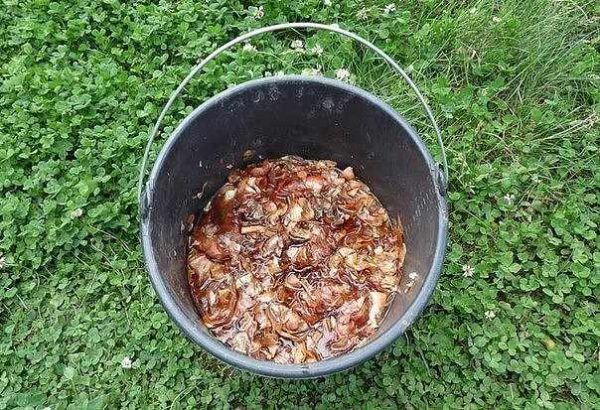
Apply:
- In case of powdery mildew on cucumbers. Spray up to 4 times with an interval of six days.
- In the case of freezing when the spring frosts of tulips, hyacinths, daffodils, crocuses need to water the flowers and they will recover.
- Used to fight spider mites.
Summary table of organic fertilizer applied on site
| Fertilizer types | Benefits | disadvantages |
| Ash | It makes the soil looser, saturates with useful substances, reduces the level of acidity, the seeds soaked in ash solution germinate faster. | Excessive soil leads to the extinction of earthworms and beneficial bacteria. If the roots come into contact with the ashes, the roots of the plants can get burned. |
| Lime | Reduces the level of acidity of the soil, the soil becomes looser, better retains moisture, neutralizes the action of toxic metals –Fe, Al and Mn. | Not applicable to all cultures. Do not use for potatoes, tomatoes, sorrel, parsley, peas, zucchini, pumpkin. Carrots and radishes stop giving birth. |
| Mustard cake | Increases yield, protects plants from diseases and pests, cleans the soil from root rot.
|
In contact with the root system, the roots of the plant get burned. |
| Coffee grounds | Stimulates the growth of young seedlings, improves the condition of the soil, creates a favorable environment for earthworms, frightens off pests | When used as mulch it dries out and creates a crust on the surface of the soil. |
| Fallen leaves | Loosens the soil, saturating it with oxygen and moisture. Serves in winter as a covering material, protecting plant roots. | |
| Husk of Seeds | Loosens the soil, makes it breathable. When used as mulch, it prevents the evaporation of moisture and weed germination. | When used as a mulch, it is not recommended to irrigate with a hose, since the pressure of the water breaks the mulch layer. Long decomposes and pulls nitrogen from the soil. |
| Straw | The content of nutrients. Makes the soil crumbly. Increases the ability to pass and retain moisture. | Slow decomposition process (3-5 years). Decomposing, saturates the soil with harmful acids. Organic compounds decompose under the condition of a large amount of moisture. |
| Onion Husk | Kills fungal and viral bacteria. Does not harm the root system. Contains many nutrients.
|
Infusion can not be used after a time. Loses its properties.
|
Currently, the use of organic fertilizers is gaining the most popularity. They can be obtained through the proper use of animal waste and horticulture. The economic approach will provide you with an environmentally friendly and useful supplements.
